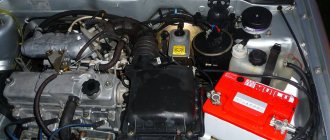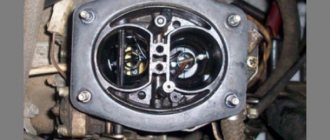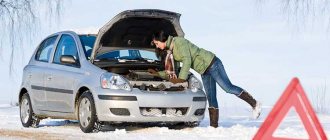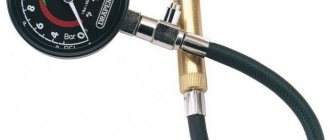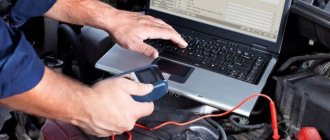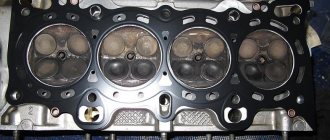A car that stalls while driving can create a dangerous situation no matter where it occurs.
If you are driving, even at low speed, and your car suddenly stalls, it is quite possible that someone will not be able to brake in time and will crash into the rear bumper of your car. And if the car stalls on a busy highway, then there is a high probability of getting into a very serious accident.
If your car stalls while driving and won't start, the possible reasons can be very varied. In this article we will look at the 6 most common reasons for this behavior of a car on the road, and also consider methods for solving this problem.
First reason – Generator malfunction
Alternator failure is one of the most common reasons why a car stalls while driving. Most drivers believe that if the generator fails, the car will not start. In practice, everything is a little different, if the battery is charged, your car can be started, and it will work even with a faulty generator.
The thing is that at this moment the car is powered not by the generator, but by the battery. But this will ultimately lead to the car stalling at the most inopportune moment and no longer starting due to the low battery charge.
Checking the battery charge level is very simple using a voltmeter. The check should be carried out after the car has been parked for several hours. All manipulations are carried out with the engine turned off and the headlights off. Open the hood and connect a voltmeter to the battery terminals. To do this, the positive terminal of the voltmeter must be connected to the positive terminal of the battery, the negative terminal to the negative terminal.
Remember that fully charged car batteries should show a charge of at least 12.66 volts. At voltage values below 12 volts, the car most likely will not start. And when measuring the voltage with the car running, normal parameters are considered to be somewhere around 13.4 - 14.4 volts. Values lower or higher indicate a malfunction. Look for a problem in the generator or relay regulator.
Why did the car stall on the road?
A more dangerous situation will be when problems with the engine arise along the way. On a busy road there is a high risk of an accident. When the car stalls while driving and does not start, you need to look for the problem depending on the type of engine. In this situation it is crucial.
In addition to the banal lack of fuel in the tank, there are a number of reasons, different for each type of engine.
A carburetor engine may stop working due to factors such as:
- Contamination of fine and coarse filters.
- Fuel pump malfunction.
- Lack of spark - it can be caused by a malfunction of spark plugs, switch, Hall sensor, distributor.
- Carburetor jets are dirty.
- Oxidation of wires.
Diagnosing the reason why the car starts and stalls after a while with an injection engine is more difficult than with a carburetor engine. In addition to problems with fuel supply and clogged filters on the engine, the crankshaft position sensor on the injector may fail. If it is not replaced, the engine will not start. You can detect a malfunction using a multimeter. Faulty injectors can also cause the car to stall.
When the car stalls while driving and then starts, the problem will most often be due to a poor fuel composition. For vehicles with automatic transmission, the power supply system may be damaged. The settings may go wrong if the gears are changed too quickly.
Ignition malfunction does not apply to a diesel engine, since it simply does not have this system. Fuel ignites on its own due to pressure. The presence of electronic parts in modern diesel engines complicates the process of identifying faults. A diesel engine may stall due to a loss of fuel supply, dirty filters, or a faulty shut-off valve.
If the car starts and stalls and stops starting, and there are no obvious reasons for the malfunction, then you should go to a quality service center to have professionals take care of the vehicle.
There can be many factors that cause a car to start and stall. Depending on the complexity of the problem and the skills of the motorist, it can be solved on your own or after contacting a service center. Regular inspection will probably prevent a number of causes.
Second reason - Fuel pump
Unfortunately, there is no warning that your fuel pump is about to fail. The first time you notice any problems is only after the car stalls. And with this malfunction, the car cannot be started again.
The serviceability of the fuel pump can be determined by a characteristic light buzzing sound after turning the key in the ignition to start the engine. If you don't hear any noise from the fuel tank when you try to start your car, it's likely that your fuel pump has failed. Since the car will not move with this problem, all you can do is tow the car to a car service center.
The third reason is that too much moisture has entered the fuel.
If gasoline contains too much moisture, then this mixture, entering the combustion chamber, does not burn properly, interfering with the proper operation of the engine. If you recently refueled, and before that the car was working fine, then the problem is most likely in the fuel.
There are two ways to solve this problem:
- The first is to drain the gasoline from the fuel tank. Then fill it with fresh fuel.
- The second is to try to dilute it with normal gasoline and continue driving with bad fuel until the car uses up all its fuel. Which, of course, is not recommended for obvious reasons. Next time, fill up at another gas station.
The fourth reason - Electrical wiring
If the car stalls while driving and does not start, and none of the above reasons apply, then bad wires may be to blame. The first thing you need to do is check the idle air control system for corrosion on the wires. If corrosion is present, then it's time to replace the wiring. It is also equally important to ensure that the wires are connected correctly if any repairs have been made.
Typical parameters
Despite the diverse and wide range of both design and power indicators, internal combustion engines have basic parameters with the same values.
Compression ratio and compression
The compression ratio of almost all engines of budget cars does not go beyond 11 units, and the compression in the cylinders has a nominal value and is in the range of 12 - 15 atm. The engine will start to run unstably if even in one cylinder the compression rate drops by one atmosphere. If the compression in all cylinders is less than nominal, for example, 11 atm, then the car will not start as quickly as it would with a normal value, traction performance will drop and fuel consumption will increase.
If the car stalls while driving, can compression affect this? In forced idle mode it can. When the car is driving with the throttle closed and the engine is running with some imbalance due to loss of compression in one or two cylinders, the control system tries to increase the speed with the idle speed control. The rate of power loss is not commensurate with the inertial speed of the actuators trying to stabilize the engine, and as a result the car stalled while driving.
Fuel supply
The fuel pressure in the injector rail on different brands of cars has its own specific values. On a ramp with reverse drainage of gasoline into the tank, the measured pressure at the moment the fuel pump is turned on is at least 3.0 atm and it is allowed to drop by 0.5 atm after the pump is turned off (checked with the engine not running). On a drainless ramp, the starting pressure reaches 3.8 atm and the drop is no more than 0.3 atm.
If the fuel pump suddenly turns off, the car will stall while driving and will not start in the future, since the pressure in the injector ramp will drop to zero. Often there are malfunctions in which the sound of a running fuel pump is heard, but the car does not start. Having measured the pressure on the manometer, it immediately becomes clear why. The pressure gauge needle shows pressure less than 0.5 atm.
Insufficient fuel pressure in the injector rail can cause a situation where the car may suddenly stall while driving and not start.
Control unit and sensors
The control unit with the program and calibrations stored in its memory controls and instantly, based on signals from sensors installed on the engine, regulates fuel supply processes, changes the ignition timing, and maintains the required step of opening or closing the bypass channel with the idle speed regulator.
The operation of the control unit from standby mode to operational mode begins from the moment the ignition is turned on. After this, a command is received to turn on the fuel pump. If the engine does not start within 5–8 seconds, the control unit turns off the fuel pump.
When the ignition is turned on, the control unit polls the sensors, checking their voltage status and assesses the temperature of the engine coolant. Based on the data received from the temperature sensor, the advance angle for starting the engine is set and the idle speed control step takes the required value in order to maintain the starting air-fuel ratio.
When the starter is turned on, all responsibility for starting the engine falls on the crankshaft position sensor, which determines the position of the pistons in the cylinders. The signals from the crankshaft position sensor are sent to the logical elements of the control unit, which distribute which cylinder and when to inject fuel and ignite the mixture. The main functional purpose of the crankshaft position sensor is to synchronize the operation of the injectors and ignition coil according to the position of the crankshaft.
For more accurate synchronization, some cars additionally install camshaft sensors.
In the electronic control system, possible causes of engine stalling while driving and subsequent failure to start may be:
- no voltage on the control unit
- control unit malfunction
- crankshaft position sensor malfunction
- Malfunction of the camshaft sensor (on certain brands of cars)
- Coolant temperature sensor malfunction
Timing
The most important characteristic in engine operation is the correct operation of the gas distribution unit. The timing assembly consists of a belt (chain), a drive gear (sprocket), a camshaft and a valve mechanism.
For stable engine operation, low fuel consumption and good dynamic performance, it is important that the camshaft rotates synchronously with the crank mechanism and that the valve thermal clearances are maintained in accordance with the manufacturer's requirements. Failure to comply with the requirements results in a loss of dynamic compression in the engine cylinders, and it may stall due to a drop in power and not start.
Sudden stalling and subsequent inability to start the engine occurs due to a broken timing belt (chain).
Sparking
Lack of spark at the spark plug electrodes is the main reason for a stalled engine. Without a spark, it is impossible to start such an engine.
The reasons for the loss of spark may be:
- crankshaft position sensor malfunction
- ignition coil malfunction
- lack of voltage in the primary winding of the ignition coil
- control unit malfunction
Fifth reason – Low fuel pressure
If your car stalls while driving up or down hills, the problem may be low fuel pressure. If this problem occurs, your machine will not operate reliably.
There may not be many possible reasons for this:
- Excessive wear and, as a result, reduced performance of the fuel pump.
- Clogged fuel system, including pump and filters.
- Vacuum in the fuel tank.
Generally, the vehicle can start and drive on smooth roads without difficulty. However, when going uphill, the car is likely to stall due to low pressure in the fuel system.
Sometimes replacing the fuel filter helps to correct the situation. This is one of the simplest solutions. You can also try adding a little injector cleaner to the fuel tank, but this comes with its own risks.
The car won't start. The most common malfunctions.
Before reading the article, remember if the warning lights on the instrument panel came on, if the engine temperature rose, or if there were any suspicious smells or sounds. Any detail will help you diagnose a malfunction faster, since almost any breakdown makes itself felt before the car stalls. So, if you remember that something similar happened to your car, then scroll through the article below, and now let’s look at the main malfunctions due to which the car may not start:
- Running out of fuel . Pay attention to the fuel sensor. Do not let the needle drop below the red zone, and it is best to refuel when the fuel needle approaches 1/4 tank;
- Malfunction of the fuel system, including filters;
- Alarm malfunction;
- Malfunction of the ignition switch;
- Malfunction of electrical wiring;
- Problems with the battery or its charge;
- Malfunction of sensors that monitor the operation of the car;
- Blown fuses;
- Faulty spark plugs;
- Starter failure;
- Oil leak;
- Engine overheating.
Why a car may not start
As you can see, there are a huge number of faults that may cause your car to not start. But if you start to look into it, more than half of them can be immediately discarded. Let's start in order, divide all potential breakdowns into groups and begin diagnostics.
- If any extraneous sounds, or odors and leaks were heard, and the car then stopped abruptly, then the first thing you should do is conduct a visual inspection of the engine compartment.
- If your ignition turns on (the lights on the dashboard are on) and the starter turns, then most likely the problem lies in the fuel system, alarm system, or ignition system;.
- If nothing lights up on the dashboard when you turn on the ignition, or lights up but dimly, or smells burnt, then the first thing we look at is the electrical component of the car.
Now let's look at each malfunction in more detail and consider diagnostic methods. It’s very good if you have a car scanner at hand. With its help, it will be possible to detect the cause of the malfunction much faster. I advise every motorist to purchase this accessory; its cost is about 500 rubles. Detailed instructions for connecting the scanner via a smartphone to a car can be found HERE.
Sixth reason – Problems with the ignition distributor cap
The distributor cap plays an important role in the performance of your engine. The cover is necessary to protect the distributor and its internal rotor. The distributor cap supplies voltage to the spark plugs. If there is something wrong with the cover, the engine may stall or stall. Problems can also be identified by the following signs:
- Presence of holes in the lid;
- Poor condition of the body, namely the presence of cracks;
- Wear or corrosion on contacts;
- Condensation in the housing itself.
If the reason is contacts or cracks, then sometimes it is enough to simply clean the contacts and treat the cover with sealant. Of course, this will not completely solve the problem, but as a temporary measure it is quite suitable. Since this problem will return again and, as a rule, at the most inopportune moment.
Other possible reasons why a car may stall while driving
Remember that a car consists of many interconnected mechanisms and components, and a car can stall while driving not only due to problems in the engine, but also due to other vehicle systems.
Here is a list of equally common faults that can cause the engine to stop:
- Engine overheating;
- The coolant temperature sensor or crankshaft position sensor is faulty.
- The fuse has blown.
- Oil or antifreeze has leaked.
- Problems with the throttle valve.
- Clogged spark plugs.
- Wear or damage to crankshaft or timing gear elements.
- The fuel or air filter is clogged.
And even this is not the entire list of problems. If your car stalls while driving and won't start, a possible reason could be that you simply ran out of gas. Yes, you can get into such a situation if you don’t refuel on time.
This is only a small part of the problems that a driver may encounter on the road. But we hope that they will be enough to solve your problem. In any case, if you are a novice driver and have little understanding of how cars work, then the best option is to call someone who knows better about this topic than you. We hope that this article was useful to you. We wish you success and good luck on the roads!
New articles
- Why does a diesel engine stall when cold and smoke white smoke? - Let's look into the issue
- Causes of deposits on spark plugs: white, black, red
The car stalls while driving, then starts. Possible causes, elimination
Stas [stas90]
08/17/2017, Views: 130262
Often car owners are faced with a very unpleasant problem: the car suddenly stalls while driving. Then immediately, perhaps after a certain time, it starts up again and drives as if nothing had happened. Such faults at service stations belong to the class of flickering faults; many workshops charge double the cost for their repair. And this is understandable: it can be difficult to detect. After all, as a rule, the so-called general effect works here in reverse. If an auto electrician comes to such a call, the car starts up as if nothing had happened and works until the technician leaves. I myself have found myself in such situations more than once. First, let's figure out, in general, what is needed for the engine to work.
Conditions for normal engine operation
For stable operation, internal combustion engines require:
- constant injection of air, and in proportions corresponding to the fuel;
- optimal pressure in the ramp;
- normally working nozzles (injectors);
- correct ignition angle;
- serviceable sensors and actuators of the engine control unit;
- required compression;
- in gasoline cars - plus an ignition spark.
In motorist parlance, an engine needs air, fuel, compression and ignition.
From the point of view of the likelihood of failure of the internal combustion engine, gasoline engines are more vulnerable, because they have an additional system - a high-voltage ignition unit, which is very sensitive to operating weather conditions. Drivers know that once a diesel engine is started, it can “burb” all day long, although not always.
Why does it happen that a car stalls and then starts? The most likely causes of this malfunction include:
1. Immobilizer problems
An immobilizer poses a great danger to most motorists. And this is understandable: you can’t deal with it without special equipment, and the services of auto electricians to fix problems with the immobilizer are expensive. If for some reason the immobilizer blocks the engine control unit, then different car models behave differently. In BMW, if there are problems with the immobilizer, the starter usually does not even spin; most models allow you to try to start it. But in Renault, as in some other models, the engine usually starts, but after a few seconds it stalls. Then it starts again, and after the same time it stalls. This can go on indefinitely.
Immobilizer synchronization failure occurs for the following reasons:
- use of a non-original key or loss of a chip from it;
- battery discharge in the key, if the circuit provides power to the chip;
- breakage of the pumping loop (located in the area of the lock cylinder);
- failures of car alarms with auto start (transponder);
- Malfunctions in the power supply circuits of the engine control unit, immo.
Just in case, you can check if your key has a chip.
If your car has an on-board computer, an immobilizer failure will be indicated in the form of a message such as IMMO or SECRET SERVICE, KEY or a blinking yellow LED. It should be remembered that if you started the car and drove it a few hundred meters, the immobilizer has already synchronized with the engine control unit, its sudden stop will in no way be related to this problem. That is: stopping the engine while driving is not an immobilizer problem!
2. Crankshaft sensor malfunction
It is responsible for overall ignition timing in both gasoline and diesel engines. If the sensor is faulty, then in 95% of cases the car will not start at all. But if the sensor is on the verge of its performance, then the engine may fail. The fact is that the sensor is usually electromagnetic. It represents an inductor wound with an extremely thin wire around a magnetic core. During use and wear, moisture may enter it. When the engine heats up while driving, the sensor coils may open and the engine stalls. Then, while you are struggling to start it, the engine cools down, the sensor coils close again, and the car starts up as if it should. So: a typical situation for a faulty crankshaft sensor: the engine starts when cold without problems, after 15 minutes of driving it suddenly stalls, then, after you wander around the car for half an hour, it starts again without problems. Advice for car enthusiasts - moisten a rag with cold water and place it on the sensor. Somehow you will get home while the sensor is cooling.
By the way, this malfunction may not be diagnosed when it is cold.
3. Flow meter malfunction
This sensor is involved in the quality formation of the mixture. If the flow meter is clogged (this often happens on run-down engines, it becomes clogged with oil), the mixture is formed enriched, it can flood the spark plugs. At idle speed in traffic jams or when coasting, this can cause the engine to stall. Then the engine starts with difficulty again, and so on. You can try cleaning the flow meter with carburetor cleaner. Many car enthusiasts turn it off altogether and, if the car stops stalling, they drive like this for a couple of years.
Installing a new flow meter to replace a heavily contaminated old one solves the problem for a short time. If the piston group or valve stem seals are very worn, the sensor will soon become dirty again.
4. Ignition system for gasoline internal combustion engines
If one of the spark plugs floods or one of the high-voltage wires breaks, the engine usually does not stop. But if the ignition coil (if it is single or double) breaks down when heated, then the car may periodically stall, then start again after a while. Sometimes the coil has microcracks. In wet weather, moisture can get in there and the car may stop suddenly. Sometimes during a rainstorm or if it gets into a puddle, the ignition system becomes flooded with rainwater. Then, as it dries, everything returns to normal. There is only one way to check the ignition coil: throw in a known good one, because a broken coil can ring normally using a multimeter.
5. Idle speed control
If the idle speed is not adjusted correctly, or the governor drive is stuck, the engine may stop at idle speed. You can try cleaning bypass regulators and regulators with stepper motors.
6. Air leak
Usually leads to uneven operation of the engine, which may stall when the accelerator pedal is suddenly moved. Many service stations use smoke machines to search for leaks. Experienced mechanics use a good cigarette.
7. High pressure pump wear
If you suspect the fuel pump, it is better to remove it and take it for diagnostics.
8. Low pressure in the ramp
Typically, engine shutdown occurs due to the fault of the electronic valve pressure regulator installed in the fuel pump. As a rule, flushing the valve does nothing.
9. Fuel pump wear
In many situations, the fuel pump remains in visually working condition, that is, it seems to be pumping. But its productivity and pressure drop to critical levels. The impeller begins to pump, then the pressure decreases by an order of magnitude. The car keeps moving and then shuts up. Change the fuel pump without question. Now the pumps themselves are inexpensive, they can be replaced without equipment, which costs money.
10. Car alarm failures
Frequent malfunction. If the alarm is installed by a non-professional, even worse, in garages, it may begin to fail immediately. After 7 years of operation, all alarms begin to fail. Typically, alarm systems use fuel pump circuits to block theft. If the signal fails, fuel is cut off. Nowadays it has generally become fashionable not to install alarms, but to turn them off. There are more and more such calls to service stations. Advice: install alarms only at proven service stations, otherwise you won’t find anything in a couple of years; When buying a used car, find out the coordinates of who installed the car alarm.
If your car begins to periodically stall while driving, then start, immediately solve the problem, determine the cause of the problem and fix it. Otherwise, sooner or later it will stall for a long time.
Read about troubleshooting other problems on my blog.

